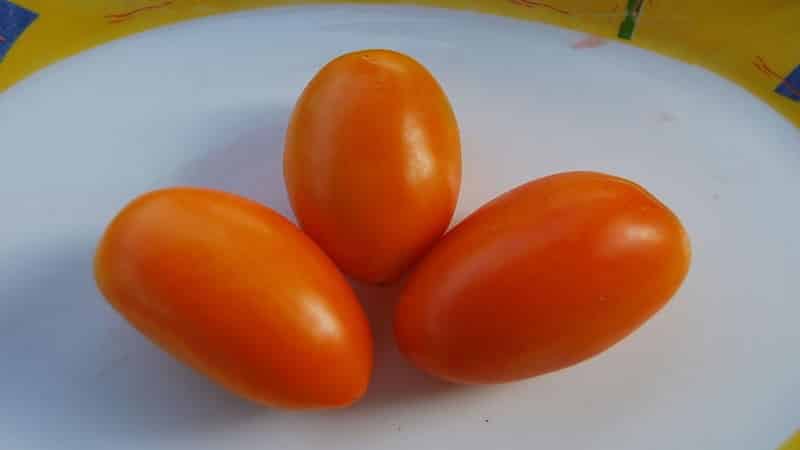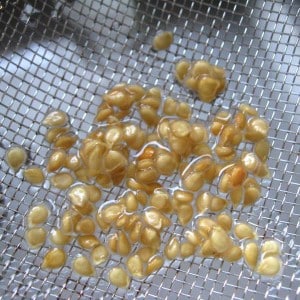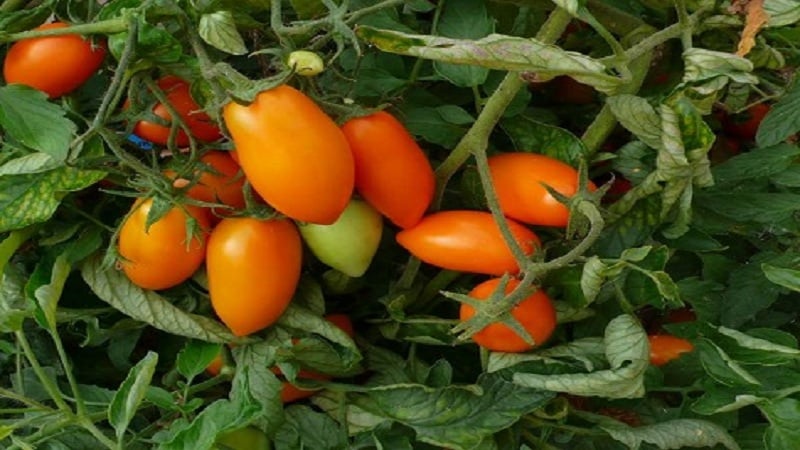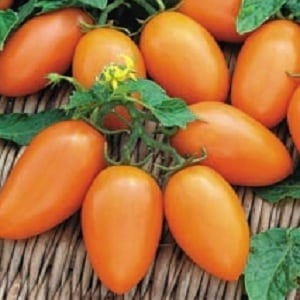Extremely viable, tasty and prolific tomato “Little Chanterelle”
Chanterelle - tomatoes with bright orange skin and an original egg-shaped shape. A distinctive feature of the variety is its extreme viability in unfavorable climatic conditions. The small, fleshy fruits of Chanterelles are very suitable for drying in the sun or in the oven. The pulp has a pleasant sweet taste and contains magnesium, vitamins C, E and beta-carotene in large quantities.
In this article we will talk about the advantages and disadvantages of the culture, the nuances of cultivation in open and closed ground.
Description of the variety
The mid-early variety Lisichka was bred by biologists of ZAO Sortsemovoshch and included in the State Register of Russia in 2007. The crop is suitable for growing in greenhouses and open ground gardens. Determinate bushes need shaping. Thin stems are tied to supports.
The photo shows the fruits of the Chanterelle variety.

The table shows the distinctive features of tomatoes.
| Indicators | Characteristic |
| Weight | 100–150 g |
| Form | Obovate |
| Coloring | Orange |
| Leaves | Large, green |
| Type of inflorescences | Simple |
| peduncle | With articulation |
| Number of slots | 2-3 |
| Pulp | Juicy, oily |
| Taste | Sweet, pleasant, but mild |
| Skin | Thin, smooth, does not crack |
| Purpose | For fresh consumption and whole canning |
| Bush height | 60–90 cm |
| Ripening period | 100–110 days after germination |
| Productivity | 9-10 kg/m² |
| Sustainability | To verticillium and fusarium, mosaic virus |
| Transportability | High |
Growing seedlings
Chanterelle tomatoes are grown through seedlings.Sowing work begins in the third ten days of March or the first ten days of April, 55–65 days before planting in the ground.
Seed preparation

Seeds - purchased or collected by hand from grown tomatoes - are pre-disinfected. Soak potassium permanganate in a pink solution for half an hour or keep it in a 2% hydrogen peroxide solution for 10 minutes.
Treatment with growth stimulants “Zircon” or “Epin” will increase the percentage of seed germination.
Soil preparation and sowing
The seeds are sown immediately in peat or plastic tall glasses. The seedlings of this tomato variety look weak, and the method without picking will relieve the seedlings from stress during transplantation.
The soil for sowing is prepared from equal parts of black soil, peat and river sand. Disinfect the soil with boiling water or a dark pink solution of potassium permanganate, place it in the oven for calcination and keep it in the cold for 2-3 days.
The cups are filled with a damp substrate, 2 seeds are sown to a depth of 1 cm, sprinkled with a 1 cm layer of soil on top and moistened with a sprayer or syringe. The containers are covered with film and placed in a dark and warm place. The optimal germination temperature is +23 °C.
Seedling care
After the shoots emerge, the cups are placed on a windowsill with good lighting. Water 1-2 times a week, when the top layer of soil dries.
To strengthen seedlings, fertilizers “Agricola”, “Shine”, “Baikal”, “Effecton” are used. Manufacturers indicate the dosage and method of use on the packaging.
Seedlings of the Chanterelle variety do not need hardening before planting in open or closed ground. The culture withstands sudden changes in air temperature.
Agricultural technology of tomatoes
Chanterelle tomatoes are easy to care for and resistant to adverse weather conditions.Medium-sized bushes require pinching, and thin stems require garters to supports.
Landing
Transferring seedlings to open or closed ground begins in late spring or early summer, after warm weather has established and the threat of frost has disappeared.
Planting pattern – 30x40 cm, 40x40 cm. No more than four roots are placed per 1 m².
Holes for seedlings are dug to a depth of 15–20 cm and filled with boiling water.
Advice. Instead of organic matter, add 3 g of superphosphate to the wells.
Seedlings in peat pots are placed in prepared holes. The soil in plastic cups is generously moistened and the seedlings are transferred into the hole along with a lump of earth.
The bushes are immediately tied to wooden stakes.
Watering and loosening
The culture loves moisture, so it is important not to let the soil dry out. For irrigation, use warm, settled or rainwater. Water strictly at the root, trying not to get on the leaves, once every 5-7 days.
Each time after watering, the soil is loosened. Weeding is carried out as necessary, carefully removing weeds.
Mulching the soil with sawdust, hay, peat or pine needles will help reduce the frequency of weeding.
Stepping and formation of bushes

Plants are formed into 2-3 stems, removing young shoots. The stepsons are carefully broken off by hand or cut off with a knife with a sharply sharpened blade.
A month after planting, the lower leaves are removed. No more than 7 brushes are left on each bush to increase fruiting.
Fragile stems often cannot cope with the weight of tomatoes, so they need timely garter.
Top dressing
After planting the soil tomatoes are fed 3-4 times, paying special attention to the bushes during flowering and ovary formation.For this purpose, organic and complex mineral fertilizers are used.
Fertilizer application stages:
- When planting seedlings, place a handful of humus and a pinch of ash in each hole.
- Two weeks after planting - potassium-phosphorus subcortex at the rate of 1 liter per bush.
- During the flowering period - 500 ml of bird droppings, 25 g of potassium sulfate, 3 g of potassium permanganate per 10 liters of water.
- During the formation of ovaries - 2 liters of wood ash, 10 g of boric acid per 10 liters of water.
Specialized stores offer a wide selection of:
- ready-made organic fertilizers: vermicompost “Vermix”, supercompost “Pixa”, compost “Reliable”;
- complex fertilizers: diammofoska, nitroammofoska, “Kemira”, “Rastvorin”.
Important! The last two feedings are carried out without adding nitrogen. Excess of the substance accumulates in fruits and soil, and leads to poisoning of the human body.
Diseases and pests
Chanterelle tomatoes are immune to verticillium and fusarium, but are susceptible to late blight. The disease can be recognized by brown spots on the leaves, fruits and stems, a whitish coating on the back of the leaves, and deformation of the fruits.
Preventative measures will help prevent infection and save the harvest:
- treatment of greenhouses with sulfur bombs;
- soil disinfection with copper sulfate;
- preventing stagnation of water in the beds and moderate watering at the root;
- removing the lower leaves;
- frequent loosening and weeding;
- mulching with peat, hay, sawdust, black agrofibre.
If infection does occur, the affected leaves, stems, and fruits are removed and burned. The tools are disinfected, the bushes are treated with the preparations “Ridomil”, “Quadris”, “Acrobat”, “Agate”, “Fundazol”. The dosage and method of preparing the working solution are indicated on the packaging.
As practice shows, Chanterelle tomatoes most often attack aphid, spider mites, slugs, mole crickets and scoop. But the whitefly is indifferent to the variety.
In the fight against insects Modern drugs “Grom”, “Force”, “Strela”, “Fitoverm”, “Epin”, “Flumite” are effective.
For those who want to grow environmentally friendly products, folk remedies for aphids, mites and cutworms are suitable:
- Infuse 200 g of onion peel in 1.5 liters of warm water. After 12 hours, add 50 g of laundry soap shavings and use to spray the bushes once a week.
- Place 3 kg of tomato tops in 10 liters of water. Boil for half an hour, strain and add water in a ratio of 1:3. Use to treat bushes 1-2 times a week.
- Boil 4 kg of wormwood in 10 liters of water for 20 minutes, cool and spray the plants once a week.
An infusion of hot pepper will help get rid of mole crickets. For 10 liters of water take 150 g of pepper and 400 ml of vinegar 9%. Leave for 24 hours and pour 500 ml of product into each hole.
They organize a night hunt for slugs - they collect the pest by hand or spray the bushes with a solution of ammonia (4 tablespoons per 10 liters of water).
Advice. Plant marigolds, fragrant dill, chamomile, fennel or mint near the tomato beds. This will attract ladybugs - faithful helpers in the fight against aphids.
The nuances of growing in open and closed ground
Difficulties in growing the Chanterelle variety, as a rule, do not arise even for inexperienced gardeners. But there is one caveat: to strengthen the root system of these tomatoes, it is recommended to periodically hill up the bushes.
The culture tolerates temperature fluctuations well and survives even when other tomatoes freeze.
The productivity of Chanterelle is consistently high both when cultivated in greenhouses and in open ground.
It is advisable to periodically ventilate the greenhouse premises; this will ensure an optimal microclimate. For prevention late blight Do not allow water to stagnate in the beds.
Harvesting and application
Chanterelle tomatoes begin to ripen approximately 100 days after the sprouts appear. Fruiting is extended and continues until the end of August. The fruits of the variety are universally used, good both fresh and for storing for the winter. A positive feature of Chanterelles is that small, fleshy tomatoes are suitable for drying in the sun or in the oven.
Gardeners note that at the stage of technical ripeness (yellow), the fruits do not have a pronounced tomato taste and aroma. It is advisable to wait until the tomatoes are fully ripe, when they turn orange, to fully enjoy their taste.
Advantages and disadvantages of the variety
Advantages of the Chanterelle variety:
- resistance to temperature fluctuations;

- possibility of cultivation throughout Russia;
- high productivity;
- long fruiting;
- ease of care;
- pleasant taste;
- excellent presentation;
- universal use in cooking;
- long shelf life (up to 3 weeks);
- resistance to nightshade diseases.
Flaws:
- the need for pinching and gartering bushes;
- sensitivity to excess moisture;
- predisposition to late blight.
Reviews
Those who have already tried to grow Lisichka tomatoes are satisfied with the result. Here's what gardeners say about them:
Alla, Lipetsk: “I’ve been growing Chanterelle for the third year in a row in the garden. Last year there was no room for several roots of seedlings, so I planted them between the greenhouse and currant bushes. Not the best place, I didn’t expect a high harvest.But at the end of July, the bushes were strewn with fruits, despite the fact that I didn’t care for them at all, only watered them abundantly.”
Peter, Belgorod: “This is one of the best varieties of tomatoes that does not require special care. I have been growing tomatoes in open ground for several years. I tie the bushes to stakes. If this is not done, fragile branches may break under the weight of the fruit. I water it twice a week at the root, always in the evening. Not my stepson, although the manufacturer recommends it. Even without this, the plant looks neat and bears fruit consistently.”
Evgenia, Odintsovo: “Little Chanterelle tomatoes grow in my greenhouse. In all these years we have never suffered from late blight. The fruits are tasty, sweet, and the flesh is fleshy. I marinade them with vinegar for the winter, prepare vegetable salads in the summer, dry them in the oven and pour olive oil with aromatic herbs. I recommend to everyone".
Conclusion
The Chanterelle tomato has gained well-deserved popularity among summer residents. It is easy to care for, resistant to diseases and adverse weather conditions. Despite its inconspicuous appearance at the stage of growing seedlings, the variety produces a consistently high yield in open and closed ground.
In conditions of elevated temperature in greenhouses, it does not lose color and ovaries. The fruits are distinguished by their pleasant taste, original shape and versatility of use.